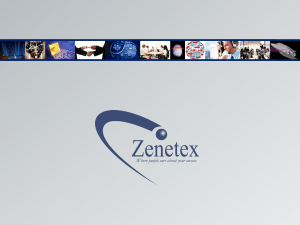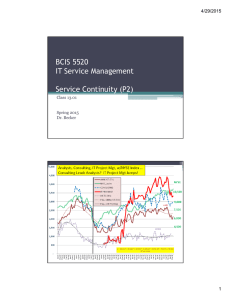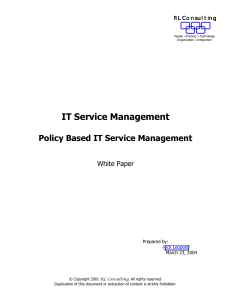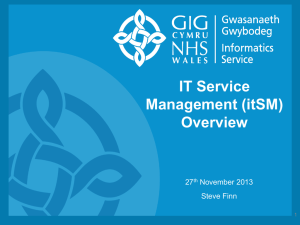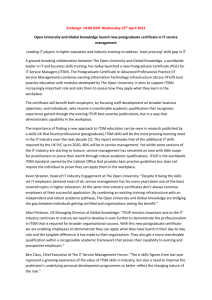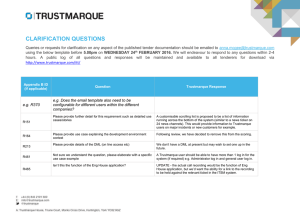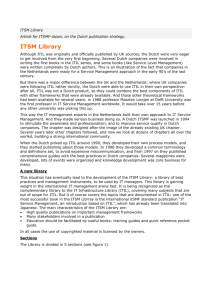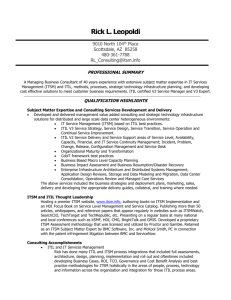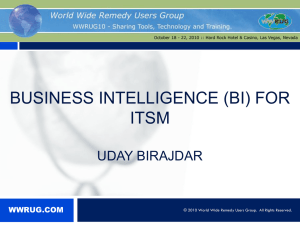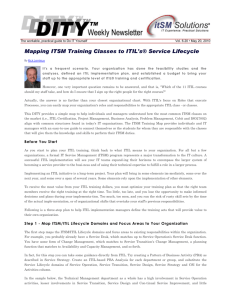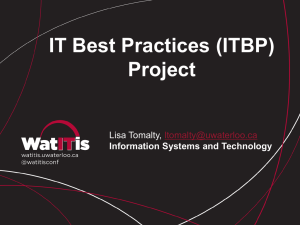ITSSM market information
advertisement
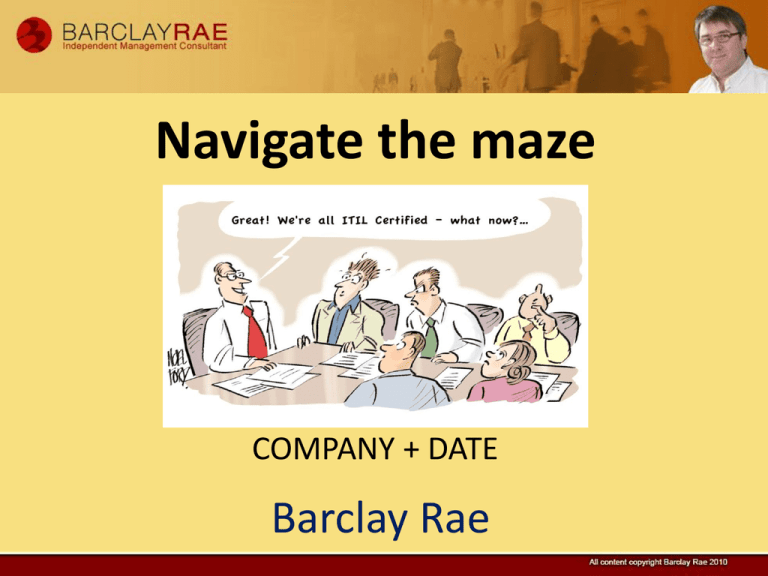
Navigate the maze COMPANY + DATE Barclay Rae Consulting, Mentoring + Troubleshooting Media + Research #ITSMGoodness 400+ consulting projects since 1994 www.itsmtv.co.uk www.barclayrae.com 2 ITSM Market Overview - 1 The market is mainly focussed on delivering niche ITSM software solutions based on ‘ITIL’ best practise. Many small and mid-sized vendors have operated exclusively in this market for the best part of 15 – 20 years. They have shared in the growth of what has been an expanding global market since the inception and spread of ITIL. Other, larger generalist IT vendors have built significant product and service-based revenue-streams based on ITIL tools and implementation expertise. ITSM Market Overview - 2 The market continues to grow globally although there is also everincreasing competition, particularly in mature saturated markets like the UK, Holland and other ITIL early adopters. As the drive for new sales is tough, vendors have to find and offer clear differentiators, particularly as ‘ITIL process’ functionality is becoming a commodity. Against that there is also the continuing residual effect of the current economic recession, which for many vendors has required cost cutting, service-trimming and re-focussing on core business offerings. ITSM Market Overview - 3 Analysts have criticised many vendors in this market in general for lack of innovation. This has generally been due to an overall lack of maturity and demand for more advanced ITIL products and process areas. Most implementations still focus around Incident, Problem and Change Management processes. It is only relatively recently that there have been more demands made from the industry (at customer and analyst levels) for more functionality and capability in this area. Wider developments such as Cloud and SaaS, Mobile, Service Catalogue, asset and financial management, plus social media and gamification have also helped to drive demand in this area,. ITSM Market Overview - 4 Vendors and products fall into 3 main areas: 1. Framework and enterprise 2. Mid-size and niche 3. Small and niche ITSM S/W Market areas Tier 1 – generally large framework vendors who provide multi-function tools across a variety of technical and business areas. Often these will have the scale and resources to maintain in-house ITIL consulting training practices – often functionally separate from their product implementation teams, e.g: HP BMC IBM CA ITSM S/W Market areas Tier 2 – midsize and niche players, who compete with the framework vendors on functionality, albeit with varying levels of ability to execute and deliver large programmes. Generally these will have some sort of internal consulting and training practise, although this is mostly focussed on product delivery. Some of these organisations may also employ industry experts and use industry media and marketing (e.g. social media) to strengthen their positions as industry leaders) E.g. • • • • • • • • • • FrontRange Hornbill LanDESK Axios Cherwell Service-Now Alemba ICCM Marval RMS ITSM S/W Market areas Tier 3 – small niche players who have established a good client base e.g. as a service desk or call logging provider, or with a broader ITIL-based product set but limited implementation and delivery capability, e.g: • • • • • • • • Sunrise House-on-the-Hill Wendia Topdesk Manage Engine OTRS Easy-Vista Zendesk Analysts etc Gartner – ITSM Magic Quadrant Forrester Wave OVUM EMA Pink Verify ITSM Review Servicesphere Gartner ITSSM 2012 MQ Key areas of functionality • • • • • • • • • Incident / Problem / Change / Knowledge integrated Reporting and MI Request and fulfilment portals Service Catalogue CMDB / Asset Management APIs and integration Workflow + process design Mobile Social Key Factors • ITSM functionality is a commodity • ‘ITIL’ functionality still sold as a panacea • SAAS/cloud model was disruptive but now pretty standard • Innovation from niche players – e.g. Biomni, IT SmartDesk, Alemba, etc • Differentiation on cost, service, implementation capability Differentiators • • • • • • • • • Tier and Scale Cost (inc lifetime) Market history and commitment Service capability Post-sales implementation capability Integration experience IP + ‘thought leadership’ Marketing and event presence Industry experts and promoters Vendor Issues • • • • • Upgrade path and lifecycle Conservative and lacking in innovation Corporate profile PMO and risk awareness Ability to manage process / project / people / organisational issues • Service and support variable • Product/sector focus for some • Niche is OK but misses opportunity for integration Project Issues • • • • • • • Clarity on objectives and measureable outcomes Clear and simple (business) focus on requirements Realistic planning and phasing Skills and experience of project teams Data collection Project Management Project measurement and accounting Recommendations • Stable and mature market – no need to build • Develop 80/20 common approach • Be clear at a business level if there are really bespoke requirements • Longer term integration provides cost and quality benefits • Tactical choices should still use common approach • Choose the vendor as much as the product
